Traditional Panettone Recipe
This post may contain affiliate links. See my disclosure policy.
Soft, light, chewy, fruity and wonderfully fragrant, Panettone is Italy’s world famous sweet bread that is traditionally enjoyed for Christmas and New Year. But you don’t have to limit yourself, with this traditional Panettone recipe you can enjoy this scrumptious treat any time of year. And if you’re like me and have never cared for the store-bought stuff get ready to be converted because homemade is a total game changer!
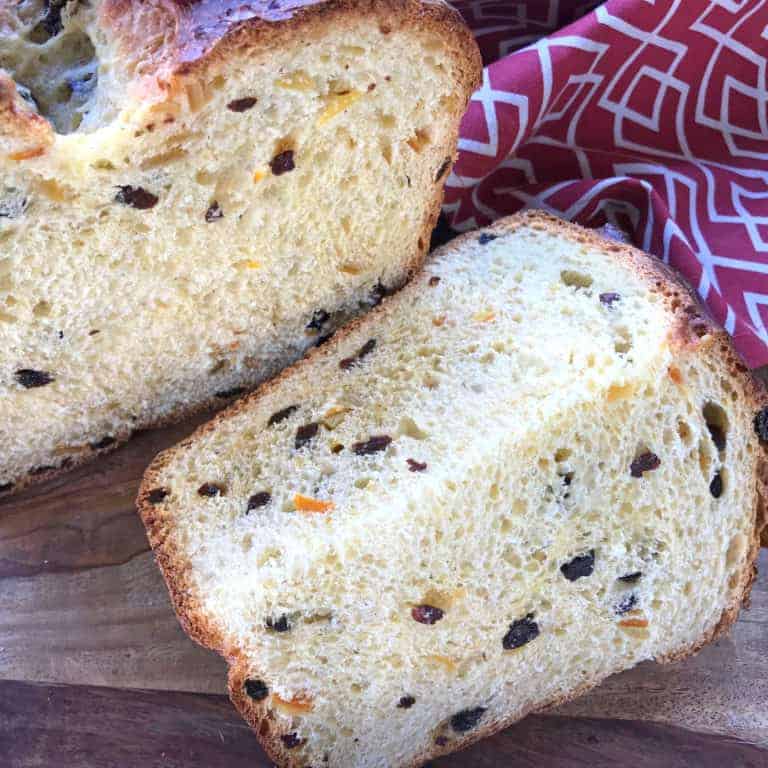
Panettone is synonymous with an Italian Christmas. Indeed, the two have gone hand in hand for centuries and to deviate from the tradition would be unthinkable. And so year after year Italian home bakers continue that tradition and for those who prefer the convenience of store-bought, Italian food manufacturers produce more than 7,100 tons of panettone each year – and only 10% of those are sold outside the country. With a population of 16.5 million people in Italy that averages out to nearly 4.5 pounds of panettone per person (adult, child and infant) per year. That’s A LOT of panettone!
What is Panettone?
Panettone is an Italian type of sweet bread loaf with sourdough-like properties usually prepared and enjoyed for Christmas and New Year’s. Panettone comes from the city of Milan in the Lombardy region of northern Italy. Milanese bakers have proudly been making it for centuries and Milan continues to host an annual panettone baking competition to determine who will be crowned the Panettone King. Like German Stollen with its characteristic oval shape that’s tapered at each end and with a bump and ridge running along the top, Panettone likewise has a very unique look all to its own. Baked in round paper molds, panettone is instantly recognizable by its tall, round stature and domed top.
There are many contemporary variations of Panettone that include things like chocolate, nuts or other dried fruits like pineapple, apricots and cherries. This recipe is for a traditional Panettone which means the only additions to the vanilla-infused batter are raisins, candied lemon and orange peel and some lemon zest (and/or orange zest depending on your preference). Though of course depending on how far back you trace its origins you won’t find candied citrus peel or yeast in the earliest known references dating back back to the Renaissance. Traditional panettone is also not rum-flavored nor are the fruits soaked in rum. The ingredients are basic, the flavors balanced, and the result absolutely scrumptious in its simplicity.
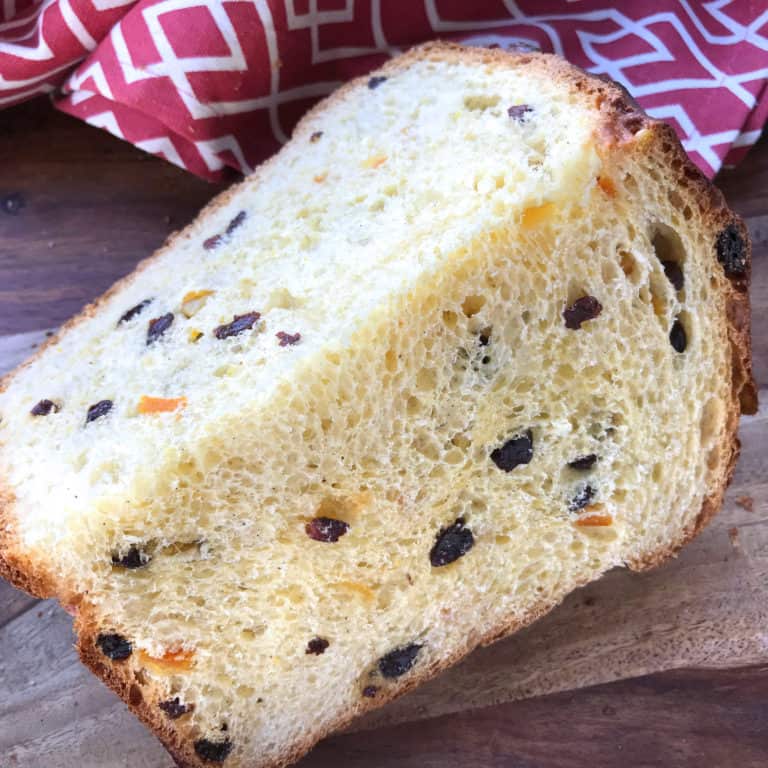
Panettone is an example of a dish that is shared across many different cultures, each having their own version of it. Similar fruit cakes/breads can be found in the form of German Stollen and Gugelhupf, Welsh Bara Brith, Irish Barmbrack, English Fruit Cake and Christmas Pudding, Scottish Dundee Cake, and many other examples.
Too often recipes will blend different traditions and styles together into one and so you end up losing the distinctness of each country’s unique version. Just as one example, adding glacé cherries and other dried fruits to Scottish Dundee Cake, thus transforming it into something more like a traditional English fruit cake instead of the unique Scottish cake that it is. Not that there’s anything wrong in doing that, it’s just that these unique varieties all start tasting kind of the same. While there is absolutely nothing wrong with altering or adding other ingredients, if what you’re looking for is a traditional Italian panettone, stick with these original ingredients.
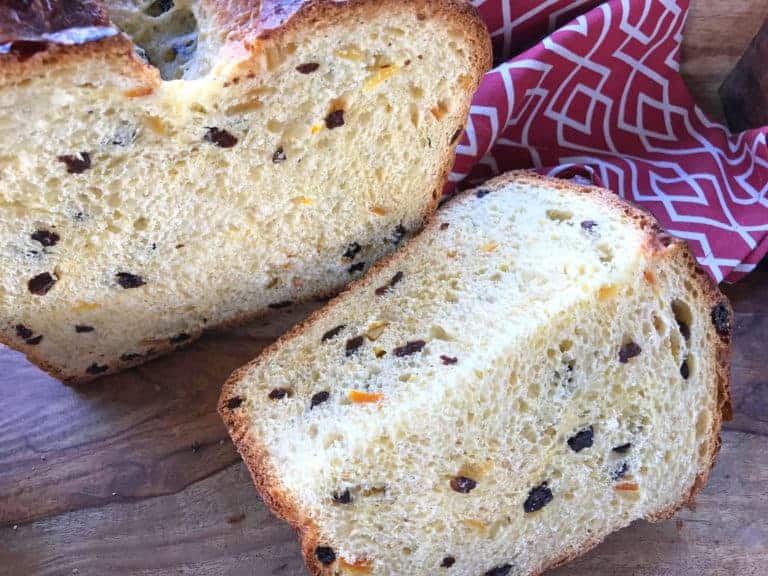
How to Serve Panettone
Traditionally Panettone is served on Christmas Day, on Santo Stefano (December 26th, a national holiday), on New Year’s Eve and New Year’s Day. It’s enjoyed for breakfast, brunch, or after a main meal. Panettone is cut vertically into wedge-shaped slices and traditionally served with tea, coffee or a sweet wine. In some areas of Italy it is served with sweetened mascarpone (crema di mascarpone) or zabaglione. It’s also wonderful sliced, toasted and slathered with butter or served with a vanilla custard sauce or fruit sauce. On a less traditional note, it’s also fabulous cubed and used for making a British-style pudding or trifle or, my favorite, dipped in egg to make Panettone French toast!
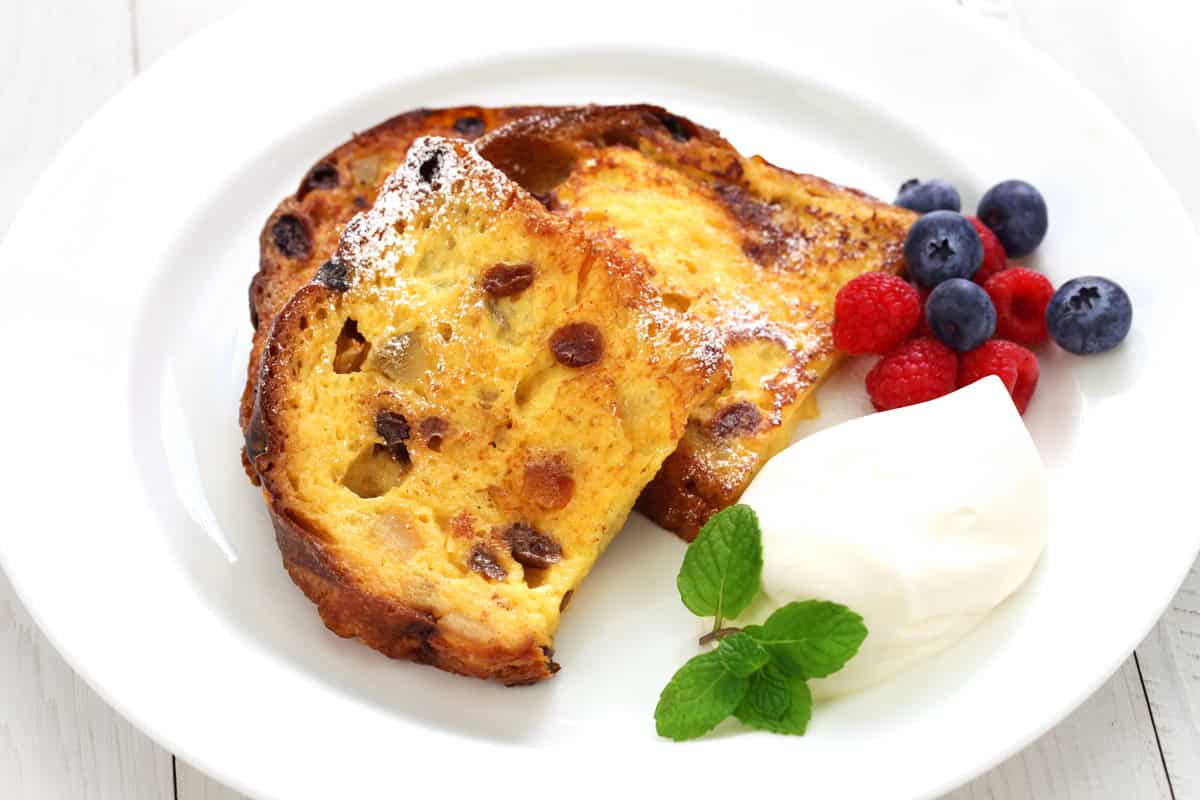
Equipment and Key Ingredients
Paper Panettone Mold: To make panettone you’ll need a traditional paper panettone mold. These are constructed of thick, sturdy paper with a smooth coating inside and are not meant to be reused.
This recipe uses a traditional 7.3″ x 4.25″ panettone mold. These molds are made in Italy and are excellent quality.
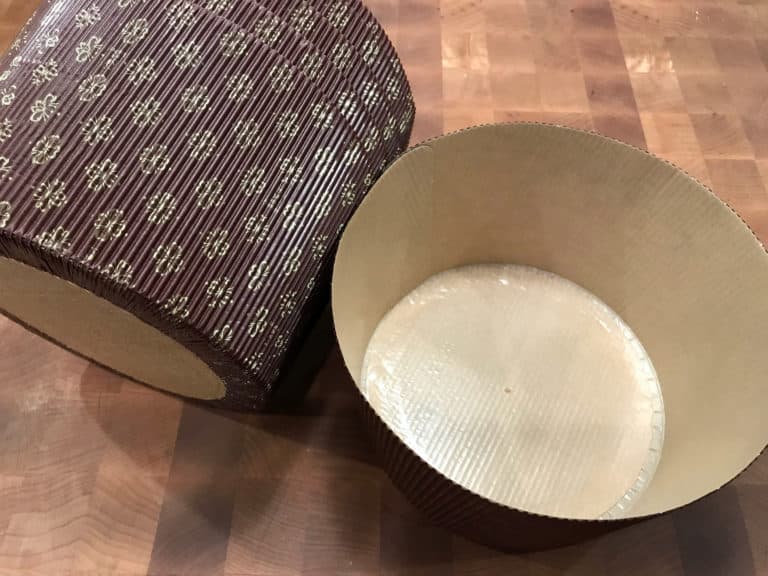
Homemade Candied Orange and Lemon Peel: Please, please, PLEASE do yourself a HUGE favor and leave the store-bought stuff on the shelf. I am not exaggerating when I say that using homemade Candied Orange Peel and Candied Lemon Peel makes ALL THE DIFFERENCE in the flavor of your panettone! It’s easy to make, can be frozen and kept for months, and trust me, you’ll be SO happy you made it!
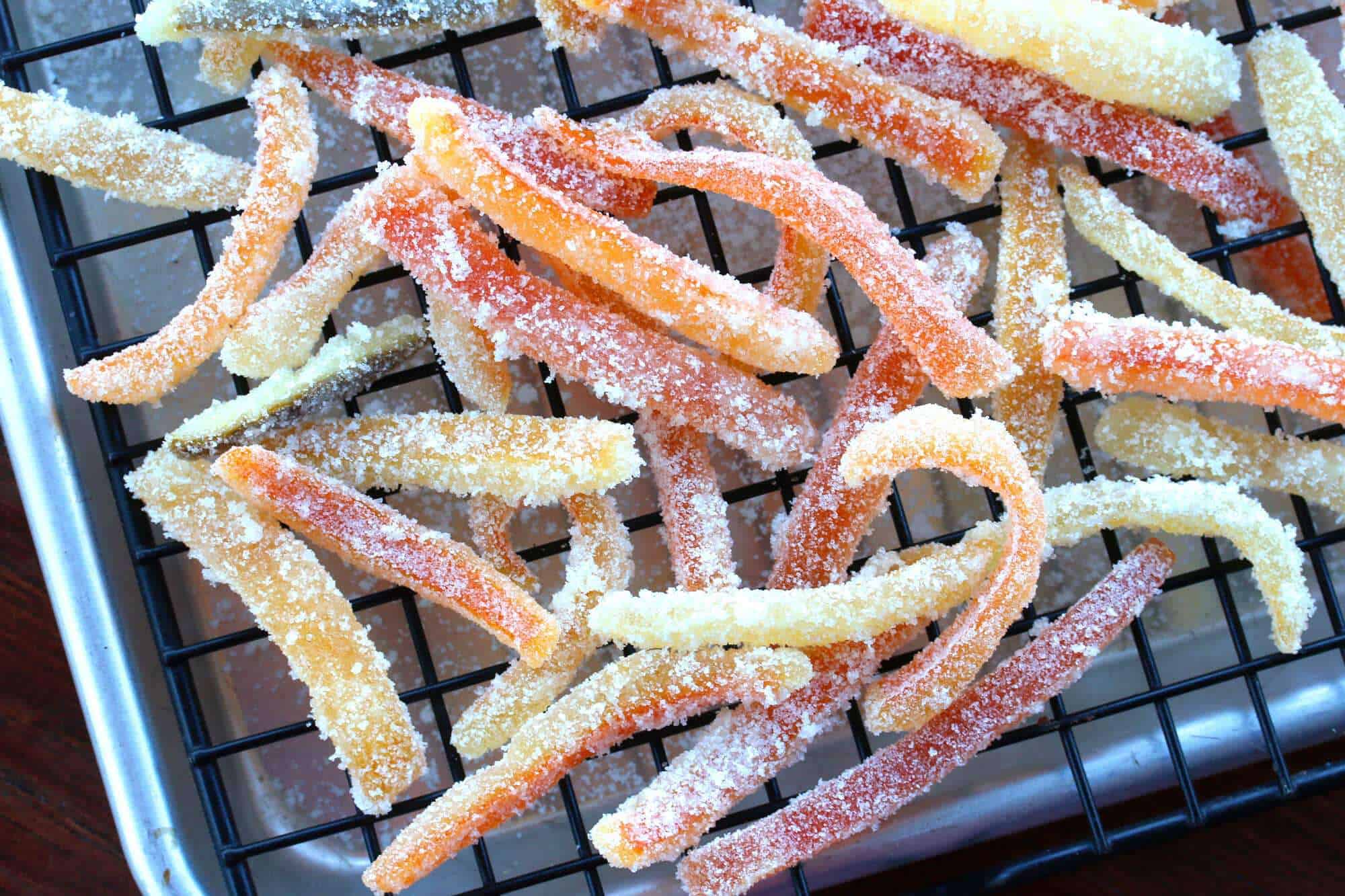
Panettone Recipe
Let’s get started!
Day 1: Make the Starter and Prepare the Dried Fruits
Place the raisins, candied lemon peel, candied orange peel, lemon and orange zest in a small bowl and pour 1/4 of hot water over them. Stir, cover and let soak for at least 2 hours or overnight. Drain any excess liquid before adding it to the panettone dough.
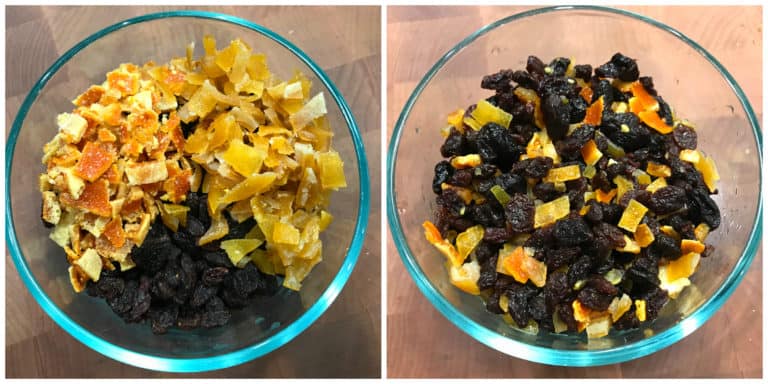
To make the starter, stir the yeast into the lukewarm water and let it sit for about 10 minutes until frothy. Place the flour and salt in the bowl of a stand mixer with the dough hook attachment (if your bowl is too large for that small of quantity knead it by hand). Add the yeast mixture to the flour mixture.
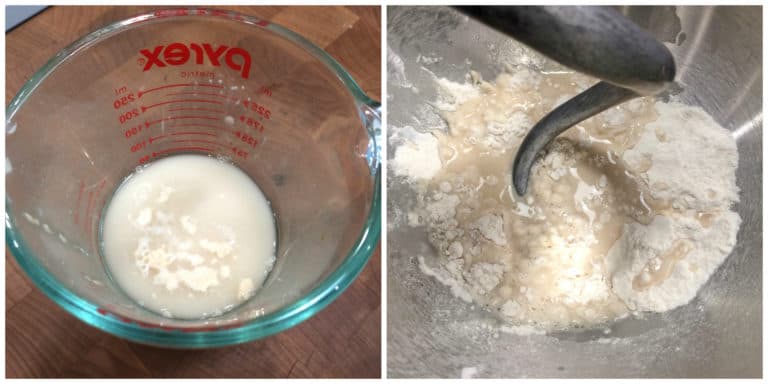
Knead for 5 minutes if using the stand mixer and about 10 minutes if kneading by hand.
Shape the dough into a ball and put it in a very lightly greased bowl, cover loosely with plastic wrap and let it rise at room temperature until doubled in size. Punch it down, cover with plastic wrap again and refrigerate it overnight.
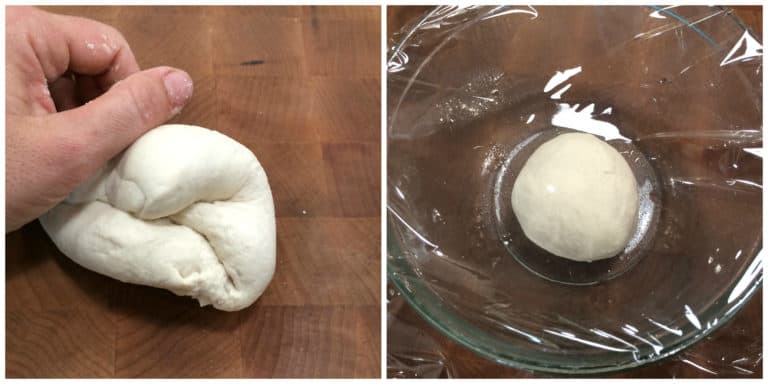
Day 2: Make the Panettone
The next day take it out and let it come to room temperature before proceeding (this will take about 2 hours). Let it rise until nearly doubled in size and then gently punch it down before adding it to the panettone batter.
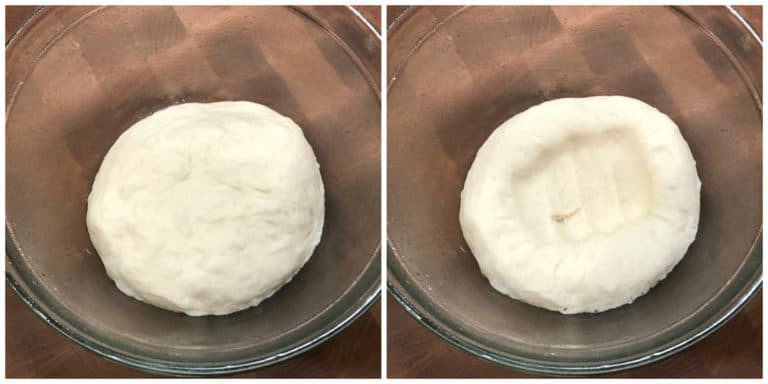
Place the flour, yeast, salt and sugar in the stand mixer and stir to combine. Attach the dough hook attachment. Add the egg yolks and milk.
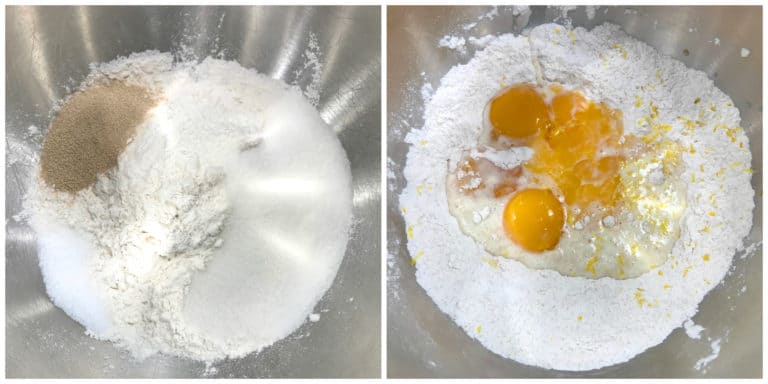
Mix it until it comes all comes together. Punch down the starter dough and add it to the stand mixer.
Knead the mixture for 5 minutes, regularly scraping down the sides.
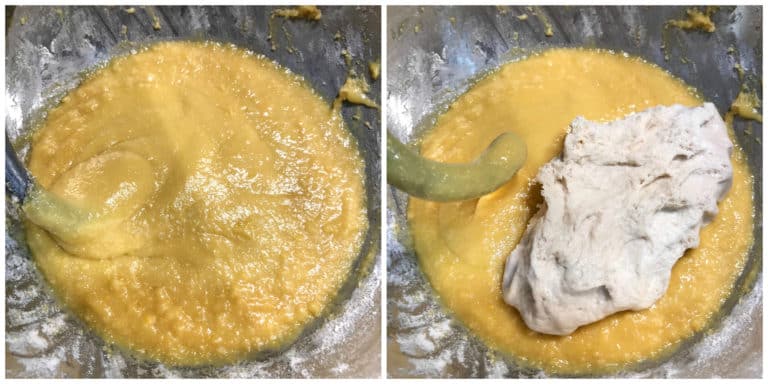
Add the softened butter, vanilla and honey and knead for another 10 minutes. (Yes, that’s 10 minutes.)
The mixture should be totally smooth and elastic but not overly sticky.
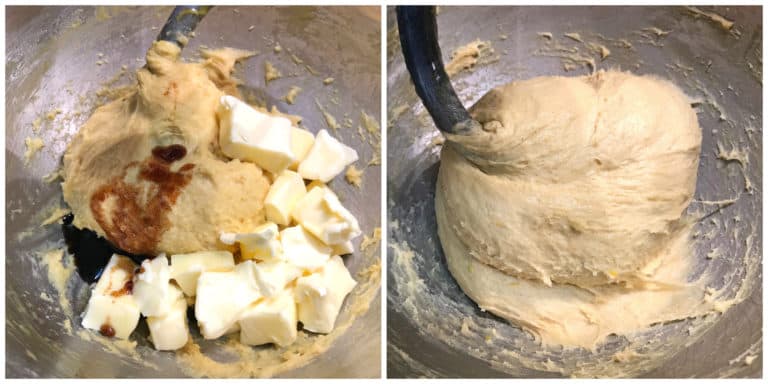
Knead the dough until the fruit is fully incorporated.
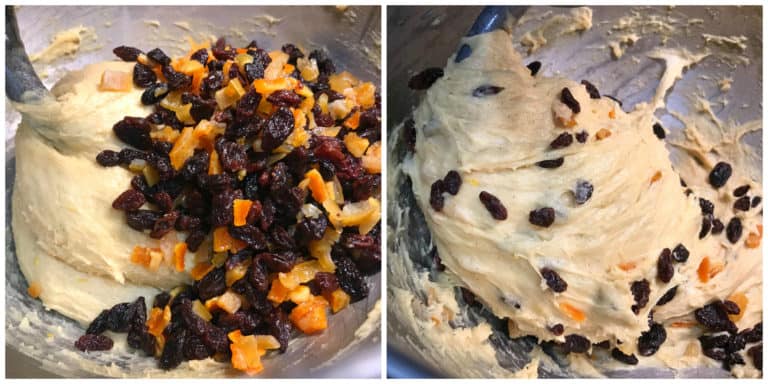
Scrape the dough down, cover the bowl loosely with plastic wrap.
Let it rise at room temperature until nearly tripled in size, about 3 hours.
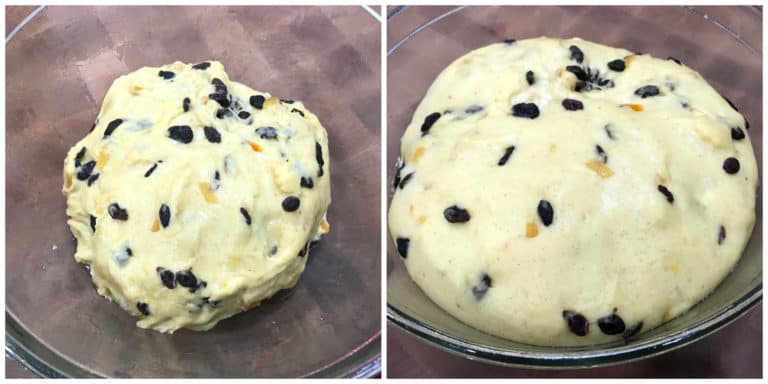
Butter the panettone mold.
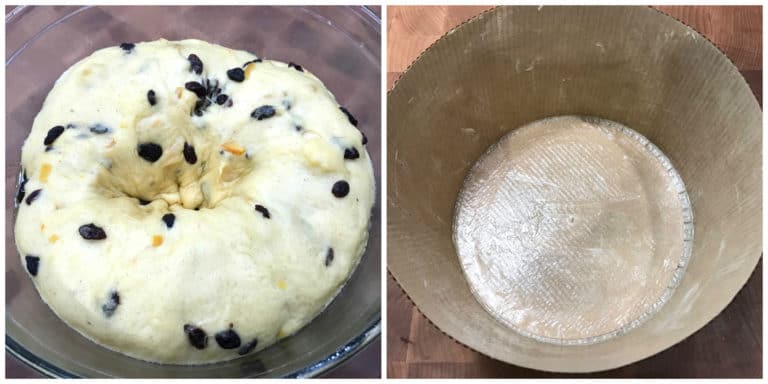
Form the dough into a ball and place it seam side down in the buttered panettone mold.
Cover it loosely with plastic wrap and let it rise for about another 2 hours or until doubled in size. It should be risen to about 1 inch or so higher than the rim of the mold.
Towards the end of this final rise preheat the oven to 350 degrees F (325 if using convection) and place the rack in the lower third of the oven.
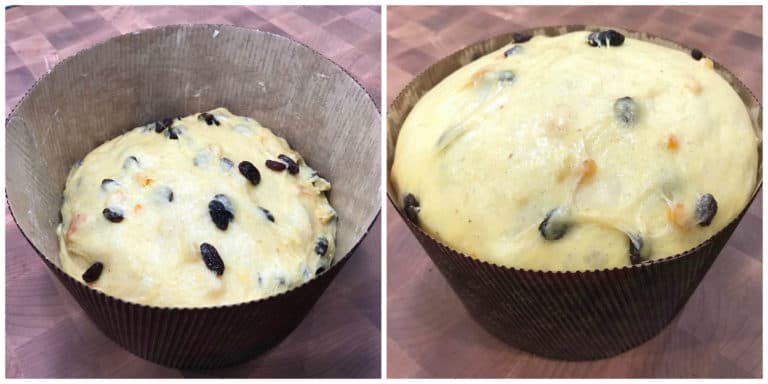
If you’d like a glossy finish on your panettone, lightly beat an egg in small bowl.
Brush the top of the panettone with this egg wash.
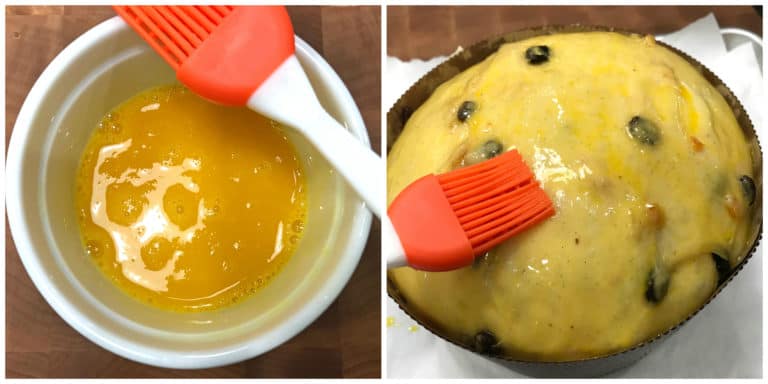
Use a very sharp knife (I use a razor blade) and score an “x” across the entire top of the panettone.
Place about a tablespoon chunk of butter in the center.
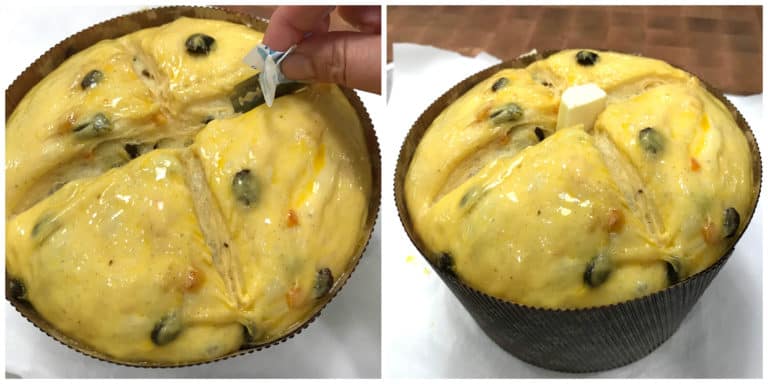
Bake the panettone for 40-60 minutes (this will vary depending on the denseness of the dough) or until a toothpick inserted into the center comes out clean (if the top is browning too quickly place foil over it). Be careful not to over-bake or the panettone will be very dry.
***Recommended: For best accuracy and to prevent under or over-baking, use an instant read thermometer. The panettone is done when the internal temperature reaches between 190 and 195 degrees F.
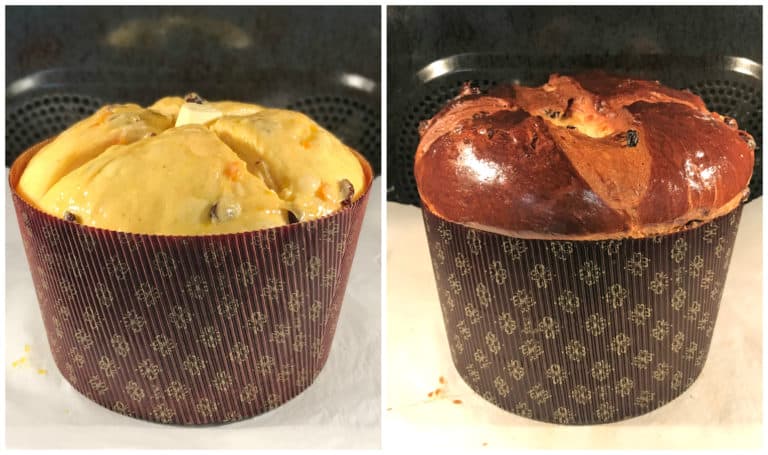
Why Do I Need To Hang Panettone?
When the panettone comes out of the oven it will cave in on itself unless you prevent it. So it is crucial to immediately hang it upside-down. To do this stick two wooden skewers through the bottom of the panettone and hang it upside down in a large pot or somewhere where it is able to remain hanging upside down until it is cooled.
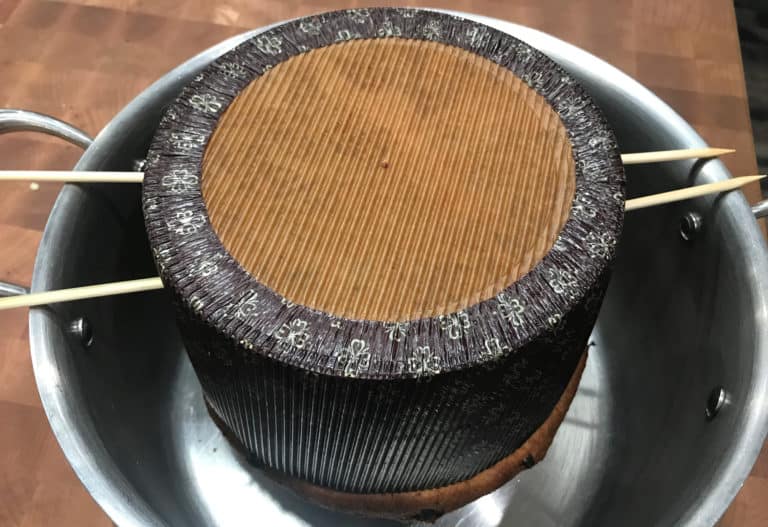
Your panettone is ready to eat! See serving suggestions near the beginning of the post.
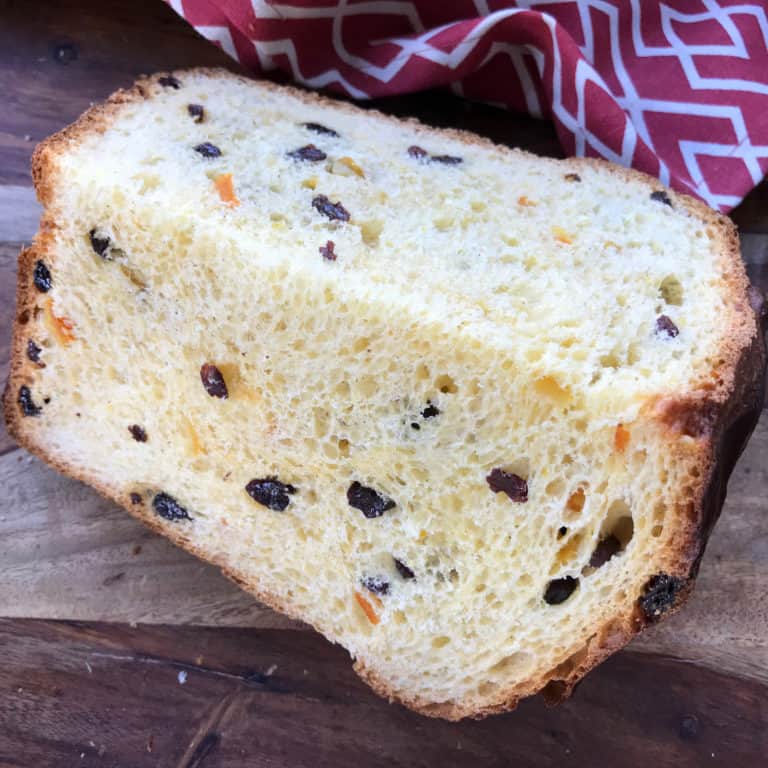
For more traditional Christmas treats be sure to try my:
- Pandoro (Verona Christmas Bread)
- Stollen (German Christmas Bread)
- Pfeffernüsse (German Iced Spiced Cookies)
- Lebkuchen (Nürnberger Elisenlebkuchen)
- Springerle (German Anise Cookies)
- Printen (Aachener Gingerbread)
- Speculoos (Gingerbread Shortcrust Cookies)
- Vanillekipferl (Vanilla Crescent Cookies)
- Zimtsterne (Cinnamon Star Cookies)
- Bethmännchen (Marzipan Cookies)
- Heidesand (Browned Butter Shortbread Cookies)
Save This Recipe
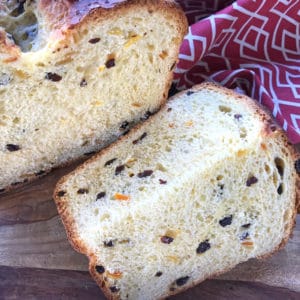
Traditional Panettone Recipe
Equipment
Ingredients
- For the Starter:
- 1/4 cup (60 ml) lukewarm water
- 1/2 teaspoon (2 g) active dry yeast
- 3/4 cup (100 g) all-purpose flour
- 1/2 teaspoon (2 g) salt
- For the Fruit Mixture:
- 1 cup (140 g) raisins
- 1/4 cup candied orange peel
- 1/4 cup candied lemon peel
- OR Homemade Candied Orange & Lemon Peel *VERY STRONGLY RECOMMENDED (using homemade makes ALL the difference in flavor! It's easy to make and you'll be SO glad you did!)
- zest of one lemon
- 2 teaspoons fresh orange zest
- For the Panettone:
- 2 1/2 cups (350 g) all-purpose flour
- 3 teaspoons active dry yeast (9 g)
- 1/2 teaspoons (2 g) salt
- 1/2 cup (100 g) granulated sugar
- 1/2 cup (130 ml) milk , at room temperature (do NOT use cold milk)
- 5 large egg yolks , at room temperature (do NOT use cold eggs)
- prepared starter (see above)
- 10 tablespoons (150 g) unsalted butter , at room temperature (do NOT use cold butter)
- 2-3 tablespoons honey
- 1 tablespoon quality vanilla bean paste (recommended for best flavor but can substitute 2 teaspoons pure vanilla extract)
- OR one vanilla bean, scraped
- 1 lightly beaten egg
Instructions
- For the Starter: Stir the yeast into the lukewarm water and let it sit for about 10 minutes until frothy. Place the flour and salt in the bowl of a stand mixer with the dough hook attachment (if your bowl is too large for that small of quantity knead it by hand). Add the yeast mixture to the flour mixture and knead for 5 minutes if using the stand mixer and about 10 minutes if kneading by hand. Shape the dough into a ball and put it in a very lightly greased bowl, cover loosely with plastic wrap and let it rise at room temperature until doubled in size. Punch it down, cover with plastic wrap again and refrigerate it overnight. The next day take it out and let it come to room temperature before proceeding (this will take about 2 hours). Let it rise until nearly doubled in size.
- To Prepare the Fruit Mixture: Place the raisins, candied lemon peel, candied orange peel, lemon and orange zest in a small bowl and pour 1/4 cup of hot water over them. Stir, cover and let soak for at least 2 hours or overnight. Drain any excess liquid before adding it to the panettone dough. Properly draining it is critical to preventing a wet dough.
- To Prepare the Panettone: Place the flour, yeast, salt and sugar in the stand mixer and stir to combine. Attach the dough hook attachment. Add the egg yolks and milk and mix until it comes all comes together. Punch down the starter dough and add it to the stand mixer. Knead it for 5 minutes, regularly scraping down the sides. Add the softened butter, vanilla and honey and knead for another 10 minutes (yes, that's 10 minutes). The mixture should be totally smooth and elastic but not overly sticky. Add the fruit mixture and knead until fully incorporated. If the dough is too wet add a little extra flour. Scrape the dough down, cover the bowl loosely with plastic wrap and let it rise at room temperature until nearly tripled in size, about 3 hours. Towards the end of this final rise preheat the oven to 350 degrees F (325 if using convection) and place the rack in the lower third of the oven.
- Gently punch down the dough, form it into a ball and place it in a buttered panettone mold (7.3" x 4.25", click link for reference). Cover it loosely with plastic wrap and let it rise for about another 2 hours or until doubled in size. It should be risen to about 1 inch or so higher than the rim of the mold. Once the panettone is risen, if you'd like a glossy top brush the top of the panettone with some egg wash (a lightly beaten egg).
- Use a very sharp knife (I use a razor blade) and score an "x" across the entire top of the panettone. Place about a tablespoon chunk of butter in the center. Bake the panettone for 40-60 minutes or until a toothpick inserted into the center comes out clean (if the top is browning too quickly place foil over it). Be careful not to over-bake or the panettone will be very dry.Recommended: For best accuracy and to prevent under or over-baking use an instant read thermometer. The panettone is done when the internal temperature reaches between 190 and 195 degrees F.
- Remove the panettone from the oven and immediately stick two wooden skewers through the bottom of it and hang it upside down inside of a large, deep pot or somewhere where it can hang as it cools. This will prevent the top of the panettone from collapsing in on itself. Once cool, slice the panettone vertically in slices. Enjoy at room temp or toasted. See blog post for serving recommendations. Stored tightly wrapped in plastic wrap it will keep at room temperature for a few days to up to a week. It is best eaten within 2-3 days.
Nutrition
Originally published on The Daring Gourmet November 12, 2019



















Love this recipe, my panettone turned out perfect. I even made the homemade candied peel and am so glad I did. It was delicious! There is no comparison to this homemade panettone and the ones you buy from the store imported from Italy. Will be making this again!
I’m so glad you enjoyed it, Sandra, thank you! <3
I tried this recipe this year again, making sure I don’t miss any detail. Last year it just didn’t rise. This year it did rise.
To me this is a delicious sweet bread, like Russian Kulich, but nothing like Italian Panettone. It’s just too dense. Panettone should have a very light, fluffy, flaky texture and when one tears pieces away it doesn’t crumble but rather slightly stretches. That is why traditionally Panettone is made over 3 days with Lievito Madre (a special starter for Panettone). That long fermentation yields a spectacular complex flavor and texture.
I made this over the weekend (December 2023) and it is a WONDERFUL recipe! The recipients said it was the best they’ve ever eaten. YAY! I used half-sized molds (3.5×5 inches) and was able to make 5 loaves from a double recipe. Each mold held just under 500g of dough before baking. And I also made the candied peel – so tasty! I was snacking on it as I baked. I do have a few observations and suggestions for future bakers. The most important one is to mix the dough at step 3 until the dough starts pulling cleanly away from the sides of the bowl and climbs the dough hook. This may take more than 10 minutes. In my case, it was closer to THIRTY (30) minutes! Nope, not kidding. That’s how long it took for the gluten structure to develop sufficiently for me to form loaves (and not just spoon sticky batter into the molds). The gluten structure is also what helps with rising. Don’t be tempted to add more flour – that’ll just make the crumb tough. As for rising, it takes as long as it takes. This is a sweet enriched dough, so “usual” yeast takes a while to work on it. Next time I’ll try the SAF yeast with the gold label, which is especially for dough with a lot of sugar in it. I expect that will speed up the rising a bit. Some have complained that shoving a skewer through the mold (for cooling the loaves) causes the mold and bread to tear. I used a sharp pointed metal turkey skewer to start the hole – just a quick jab – and then put the bamboo skewer in. No tearing at all! Without the tiny starter hole, the bamboo skewer couldn’t penetrate the paper of the mold. You can be assured I’ll make this recipe again. Maybe even next weekend!
Thank you so much for that detailed feedback, Sanny, I really appreciate it. And I’m absolutely thrilled that you enjoyed this panettone, thank you! <3
Do I need to use yeast if I am using sourdough starter? How many grams do I use of starter in the beginning?
Hi Jenna, I haven’t made this with a sourdough starter but perhaps one of our readers has tried it and can chime in with the amount they used.
The bread is wonderful! The only problem I had was cooling that loaf. When I tried pushing the wooden skewers through, it simply tore up the cardboard mold and the bread. Gave that up and cooled upright.
Hi Jean, I’m sorry the skewers gave you trouble but I’m happy you enjoyed the Panettone, thank you!
Thank you for the recipe! I have used your Stollen recipe for the past several years and the result has always been amazing. With this one I am struggling though. I have done everything according to the recipe. My dough is not rising even though I checked the yeast, it was good. All the ingredients were room temp. Water used for starter was lukewarm. Milk was lukewarm. I am going through the first rise, it’s been 5 hrs in the proof box at 83F and it barely doubled in size. Considering that it rises so poorly now I doubt that it will rise once in the molds. I would hate to throw it all away!
Hi Mara, I’m not sure why your yeast is responding so sluggishly but I’m assuming you went ahead and proceeded with baking it? How did it turn out?
Hi Kimberly,
It turned out to be very dense. Nothing like Panettone, but rather like the texture of Russian Kulich or German Stollen. It was very delicious though! I will try baking it this year again and see what happens.
Hi Mara, yeah that definitely should not be the case. It sounds like something went wrong with the yeast and proofing stage. Did you have any issues with the dough fully rising? Panettone also dries out very quickly, so proper storage is essential.
I couldn’t get size paper pan, I will be using King Arthur Flour 6×4 inch paper pan. Should I use less dough?
Hi Pam, the panettone paper molds are 7.3 x 4.25 so yes, you’ll need to add a little less dough to yours.
I’ve got my starter prepared and ready for the next step today. The starter is 2 g of yeast while the main recipe asks for 3 tsp of active yeast. Did you mean 3 g?
Hi Laura, it’s 3 teaspoons for the main dough (a little over 9 grams).
I made this today. I followed the recipe using grams. I did everything that is written. No changes.
The dough, after adding the fruit, was extremely soft. I couldn’t form a ball. I scraped it out and put it in the paper mound.
As it baked some of the batter reached over the top and crawled down the paper.
It tested done and looks ok but I couldn’t put an x-mark on the top.
Next time should I add a bit more flour to the 10 minute kneading step?
Hi Sharon, there a few things that could have gone wrong. First, it’s not supposed to form into a ball; the instructions direct scraping the dough down, cover the bowl loosely with plastic wrap and to let it rise. Secondly, this is sweet enriched dough with the added weight of a lot of dried fruits so it needs a very long rise, upwards of 3 hours. And depending on the temperature of your home it could take even longer. The third factor is that your fruit may have been too wet and not sufficiently drained.
I can comment on the batter-like consistency of the dough. The recipe says knead for 10 minutes by machine. Mine took closer to 30 minutes (not a typo) to develop sufficient gluten structure. An enriched dough like this takes longer than a regular bread. Knead until the dough pulls from the sides of the bowl (the bottom will still cling) and starts climbing the dough hook. The final dough will look like the photo in the recipe.
Also re rising, a regular yeast will take a really long time to lift a sweet dough like this. SAF in the gold package is specifically for sweet and enriched dough, and will likely work faster in this recipe. I have the regular (red) package, so I cannot compare. I can only wait.
Is it possible to make this in loaf pans? I wanted to give them as gifts.
Hi Frannie, I haven’t tried it but there’s really no reason that wouldn’t work.
I’ve made a veganized version of this recipe several times (with soy milk and flax egg substitutes), and it has been consistently amazing. My northern Italian in-laws were very impressed. Thanks for an awesome recipe! :)
Fantastic, Darla, thanks so much for the feedback!